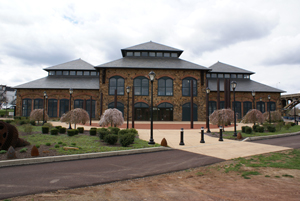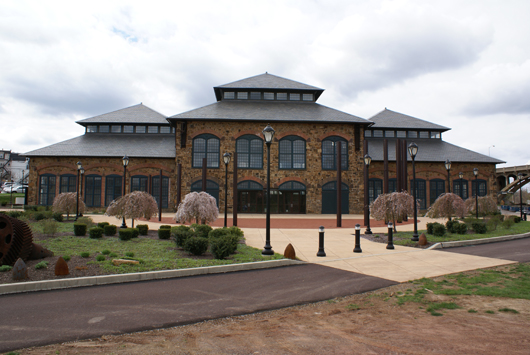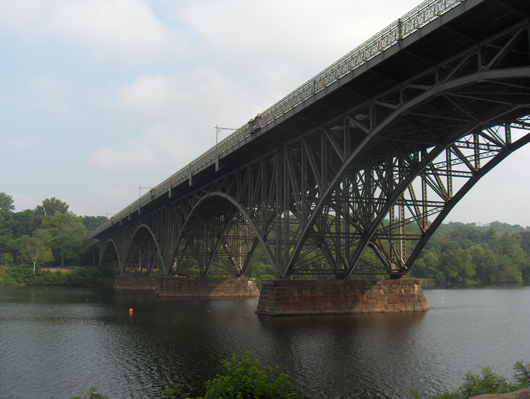
PHOENIXVILLE, Pa. (AP) – The Phoenix of Egyptian and Greek mythology was a magnificent bird that was reborn from its own ashes.
The Phoenix of Phoenixville and Chester County reality was an iron works from which arms for armies, rails for railroads, backbones for bridges, and myriad more products for industrial and domestic uses were crafted.
The Phoenix Iron Works went cold a half-century ago. But from its ashes is a gem of a park and heritage center that is symbolic of the renaissance of the town around it.
Phoenixville’s lively main street is lined with an ever-increasing roster of shops and restaurants. And just off that street is a lasting memorial and lovely monument to the natural and man-made qualities that contributed to its growth.
The Phoenixville Foundry is a conference, reception and event space within the restored walls of a circa 1882 Phoenix Iron and Steel Co. building.
It has been configured to reveal original truss work beneath a 60-foot-high ceiling of the main ballroom. A staircase winds up to the Cupola Mezzanine, and the layout is decorated with artifacts, murals and photographs from the days when the foundry was in full blast.
The largest of those artifacts is the massive, restored Wooden Jib Crane. It is believed to be the last piece of equipment of its kind in the country. It was one of four cranes that off-loaded massive forms that were sent to build railroads, buildings and bridges.
For “A Day Away” purposes, the attraction of The Foundry is its fascinating “Schuylkill River Heritage Center” in the foyer of the event spaces.
After the steel mill closed in 1987, most of the buildings on the 130 acres it consumed were demolished. The Foundry Building survived a decade of decay—just barely.
It was eventually deemed to be one of the “most endangered buildings in Pennsylvania.” And former Gov. Tom Ridge said it should be restored and house a museum that would pay tribute to the industrial history of the Schuylkill River Valley.
Chester County allocated $5.2 million that would ensure that the building would be a part of the county’s heritage and the town’s revival.
A visit to the Schuylkill River Heritage Center will begin with a walk through the Symbols of Steel Sculpture Garden. Those peculiar columns in the garden are “Phoenix Columns,” a type of bar that was widely used in construction projects here and abroad.
Inside the Heritage Center, visitors’ attention will be to the floor and an imaginative map of the Schuylkill River, its towns and tributaries. A similar map can be found on the back wall.
Several display cases hold historical items from the mill, its workers and the town of Phoenixville. And on one of the walls is an impressive, entertaining and educational array of photographs and postcards that depict bridges and structures built with Phoenix Columns.
Some of them remain, some are long gone:
- The “Phenix Wheel” from the 1895 Atlanta Cotton Exposition. A ride inspired by George Ferris’s wheel in Chicago, Phenix Wheels were built at Coney Island and on the boardwalk in Asbury Park, N.J. The Asbury Park wheel is under restoration in Phoenixville.
- The Cape May, N.J., Pier; the Heinz Pier in Atlantic City; and the Long Branch, N.J., pier—all victims of hurricanes.
- Philadelphia Water Works: Phoenix Columns were used to support the machinery in the buildings that still stand at the foot of the Philadelphia Museum of Art.
- The Washington Monument: The staircase and elevator shafts are supported by Phoenix Columns.
- Strawberry Mansion Bridge: Built for trolleys in 1896, the 832-foot-long bridge now carries traffic over the Schuylkill River in Fairmount Park, Philadelphia.
- Kinzua Viaduct: The original 2,052-foot long railroad bridge that soared more than 300 feet over the valley was the highest bridge in the world when it was built. It was removed and rebuilt in 1900.
___
Online:
___
Information from: Reading Eagle, http://www.readingeagle.com/
Copyright 2013 Associated Press. All rights reserved. This material may not be published, broadcast, rewritten, or redistributed.
AP-WF-08-15-13 1356GMT
ADDITIONAL IMAGES OF NOTE



